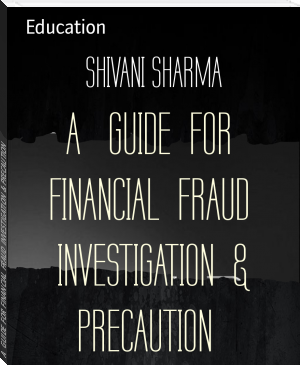A GUIDE FOR FINANCIAL FRAUD INVESTIGATION & PRECAUTION by SHIVANI SHARMA (thriller books to read txt) 📖

- Author: SHIVANI SHARMA
Book online «A GUIDE FOR FINANCIAL FRAUD INVESTIGATION & PRECAUTION by SHIVANI SHARMA (thriller books to read txt) 📖». Author SHIVANI SHARMA
Sexting and filming among minorsMain article: Sexting
Sexting is sending, receiving, or forwarding sexually explicit messages, photographs, or images, primarily between mobile phones, of oneself to others (such as dating partners or friends). It may also include the use of a computer or any digital device.[115] Such images may be passed along to others or posted on the Internet. In many jurisdictions, the age of consent is lower than the age of majority, and a minor who is over the age of consent can legally have sex with a person of the same age. Many laws on child pornography were passed before cell phone cameras became common among teenagers over the age of consent and sexting was understood as a phenomenon. Teenagers who are legally able to consent to sex, but under the age of majority, can be charged with production and distribution of child pornography if they send naked images of themselves to friends or sex partners of the same age.[116][117] The University of New Hampshire’s Crimes Against Children Research Center estimates that 7 percent of people arrested on suspicion of child pornography production in 2009 were teenagers who shared images with peers consensually.[117] Such arrests also include teenage couples or friends with a small age disparity, where one is a legal adult and the other is not.[118][119] In some countries, mandatory sentencing requires anybody convicted of such an offense to be placed on a sex offender registry.[118][119] The vast majority of underage sexual images are produced by adults, however, and adults often solicit underage teenagers to share the images.[117]
Legal professionals and academics have criticized the use of child pornography laws with mandatory punishments against teenagers over the age of consent for sex offenses. Florida cyber crimes defense attorney David S. Seltzer wrote of this that "I do not believe that our child pornography laws were designed for these situations ... A conviction for possession of child pornography in Florida draws up to five years in prison for each picture or video, plus a lifelong requirement to register as a sex offender."[120]
In a 2013 interview, assistant professor of communications at the University of Colorado Denver, Amy Adele Hasinoff, who studies the repercussions of sexting has stated that the "very harsh" child pornography laws are "designed to address adults exploiting children" and should not replace better sex education and consent training for teens. She went on to say, "Sexting is a sex act, and if it's consensual, that's fine [...] Anyone who distributes these pictures without consent is doing something malicious and abusive, but child pornography laws are too harsh to address it."[121]
In April 2018, The Daily Telegraph reported that of the sexually explicit images of children and teenagers (11 to 15 year-olds) found on the Internet, 31% were made by children or teenagers from November 2017 to February 2018, with 40% in December 2017; 349 cases in January 2017 and 1717 in January 2018. The images were made by children or teenagers photographing or filming each other or as selfies, without adults present or coercing, by unwittingly imitating adult pornographic or nude images or videos (including of celebrities) that they had found on the Internet. The report said that pedophiles trawled for and amassed such images
Software PiracyMeaning : -
A term used to describe the act of illegally using, copying or distributing software without ownership or legal rights. The majority of software today is purchased as a single-user license, meaning that only one computer may have that software installed on it at one time. Copying that software to multiple computers or sharing it with your friend without multiple licenses is considered illegal software piracy.
How do companies prevent software piracy?

Software piracy is a major issue affecting companies and developers today. Consequently, companies need to implement anti-piracy protection systems on their software-based products.
Legal protection
Most companies make sure their software is protected legally by a user agreement. Letting consumers know that making unauthorized copies is against the law will help prevent people from unknowingly breaking piracy laws.
Product key
The most popular anti-piracy system is a product key, a unique combination of letters and numbers used to differentiate copies of the software. A product key ensures that only one user can use the software per purchase.
Tamperproof
Some software programs have built-in protocols that cause the program to shut down and stop working if the source code is tampered with or modified. Tamperproofing prevents people from pirating the software through the manipulation of the program's code.
Watermarking
Watermarks, company logos, or names are often placed on software interfaces to indicate that products are legitimately obtained, and are not illegal copies.
Hacking
Hacking is identifying weakness in computer systems or networks to exploit its weaknesses to gain access. Example of Hacking: Using password cracking algorithm to gain access to a system
Computers have become mandatory to run a successful businesses. It is not enough to have isolated computers systems; they need to be networked to facilitate communication with external businesses. This exposes them to the outside world and hacking. Hacking means using computers to commit fraudulent acts such as fraud, privacy invasion, stealing corporate/personal data, etc. Cyber crimes cost many organizations millions of dollars every year. Businesses need to protect themselves against such attacks.
Who is a Hacker? Types of Hackers
A Hacker is a person who finds and exploits the weakness in computer systems and/or networks to gain access. Hackers are usually skilled computer programmers with knowledge of computer security.
Hackers are classified according to the intent of their actions. The following list classifies hackers according to their intent.
Symbol Description
 Ethical Hacker (White hat): A hacker who gains access to systems with a view to fix the identified weaknesses. They may also perform Penetration Testing and vulnerability assessments.
Ethical Hacker (White hat): A hacker who gains access to systems with a view to fix the identified weaknesses. They may also perform Penetration Testing and vulnerability assessments.
 Cracker (Black hat): A hacker who gains unauthorized access to computer systems for personal gain. The intent is usually to steal corporate data, violate privacy rights, transfer funds from bank accounts etc.
Cracker (Black hat): A hacker who gains unauthorized access to computer systems for personal gain. The intent is usually to steal corporate data, violate privacy rights, transfer funds from bank accounts etc.
 Grey hat: A hacker who is in between ethical and black hat hackers. He/she breaks into computer systems without authority with a view to identify weaknesses and reveal them to the system owner.
Grey hat: A hacker who is in between ethical and black hat hackers. He/she breaks into computer systems without authority with a view to identify weaknesses and reveal them to the system owner.
 Script kiddies: A non-skilled person who gains access to computer systems using already made tools.
Script kiddies: A non-skilled person who gains access to computer systems using already made tools.
 Hacktivist: A hacker who use hacking to send social, religious, and political, etc. messages. This is usually done by hijacking websites and leaving the message on the hijacked website.
Hacktivist: A hacker who use hacking to send social, religious, and political, etc. messages. This is usually done by hijacking websites and leaving the message on the hijacked website.
 Phreaker: A hacker who identifies and exploits weaknesses in telephones instead of computers.
Phreaker: A hacker who identifies and exploits weaknesses in telephones instead of computers.
What is Ethical Hacking?
Ethical Hacking is identifying weakness in computer systems and/or computer networks and coming with countermeasures that protect the weaknesses. Ethical hackers must abide by the following rules.
Get written permission from the owner of the computer system and/or computer network before hacking. Protect the privacy of the organization been hacked. Transparently report all the identified weaknesses in the computer system to the organization. Inform hardware and software vendors of the identified weaknesses.Why Ethical Hacking?
Information is one of the most valuable assets of an organization. Keeping information secure can protect an organization’s image and save an organization a lot of money. Hacking can lead to loss of business for organizations that deal in finance such as PayPal. Ethical hacking puts them a step ahead of the cyber criminals who would otherwise lead to loss of business.Legality of Ethical Hacking
Ethical Hacking is legal if the hacker abides by the rules stipulated in the above section on the definition of ethical hacking. The International Council of E-Commerce Consultants (EC-Council) provides a certification program that tests individual’s skills. Those who pass the examination are awarded with certificates. The certificates are supposed to be renewed after some time.
Summary
Hacking is identifying and exploiting weaknesses in computer systems and/or computer networks. Cybercrime is committing a crime with the aid of computers and information technology infrastructure. Ethical Hacking is about improving the security of computer systems and/or computer networks. Ethical Hacking is legal.
Potential Security Threats To Your Computer Systems
A computer system threat is anything that leads to loss or corruption of data or physical damage to the hardware and/or infrastructure. Knowing how to identify computer security threats is the first step in protecting computer systems. The threats could be intentional, accidental or caused by natural disasters.
In this article, we will introduce you to the common computer system threats and how you can protect systems against them.
Topics covered in this tutorial
What is a Security Threat? What are Physical Threats? What are Non-physical Threats?What is a Security Threat?
Security Threat is defined as a risk that which can potentially harm computer systems and organization. The cause could be physical such as someone stealing a computer that contains vital data. The cause could also be non-physical such as a virus attack. In these tutorial series, we will define a threat as a potential attack from a hacker that can allow them to gain unauthorized access to a computer system.

What are Physical Threats?
A physical threat is a potential cause of an incident that
 The desire to acquire knowledge about the surrounding world and human society is quite natural and understandable for a person. Life is so developed that an uneducated person will never occupy a high position in any field. Humanity in its mass, and each person individually, develops objectively, regardless of certain life circumstances and obstacles, but with different intensity. The speed of development depends on the quality of training.
The desire to acquire knowledge about the surrounding world and human society is quite natural and understandable for a person. Life is so developed that an uneducated person will never occupy a high position in any field. Humanity in its mass, and each person individually, develops objectively, regardless of certain life circumstances and obstacles, but with different intensity. The speed of development depends on the quality of training.




Comments (0)